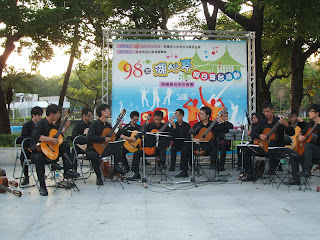To tell the truth, when I have the first sight of Wenho Temple, I think that the temple is more smaller than those i visited before, and it has no special figure, either. However, after knowing the history, I suddently usderstand its unique significance to the people in this land. In the age of inadequate technology of navigation and voyage on the sea, most of the people, who wanted to move to Taiwan to seek for a better life, had to cross Taiwan Strait, or "Black Ditch" where many shipwrecks had happened there due to the bad weather. At that time, crossing Taiwan Straight is too difficult for most people to achieve. It's said that one of ten people can survive the terrible and scaring journey. Therefore, people in southeast China, for the safty of their journey, took their local faith "Godness of the sea, Mazu" to bless that they could pass the Taiwan Strait safely. To appreciate Mazu's help, eleven celebrated families donated a lot of money to build the temple for Mazu, which is Wanho Temple now.
 Besides Mazu, there are also many Gods lke Guan Yin(觀世音菩薩), Songzi Niangniang(註生娘娘), Guan Yu(關聖帝君), and Shennong(神農大帝), etc.
Besides Mazu, there are also many Gods lke Guan Yin(觀世音菩薩), Songzi Niangniang(註生娘娘), Guan Yu(關聖帝君), and Shennong(神農大帝), etc. For the nearly 300 years, the temple has been a center of their religion and faith. In a long period of time, it has blessed the people in this land. If they had excellent harvest, these people would hold a big festivsal to appreciate her blessing.
For the nearly 300 years, the temple has been a center of their religion and faith. In a long period of time, it has blessed the people in this land. If they had excellent harvest, these people would hold a big festivsal to appreciate her blessing.To these people, Mazu faith is not only a spritiual comfort, but also in memory of their ancestors who made a lot of efforts to build their homeland. When they started living in this land. They believed that doing these religious activities, the determination and perservance could pass down to their following generations.
If we compare Mazu Temple to a tender mother, she has taken care of the people and their later generations like her children for several countries. Her children also thank their mother. On their mother 's birthday, all of them express their sincere appreciation. (Mazu's birthday-festival is on the twenty-third day of the third lunar month of Chinese calendar.) This land is like a big family.
 During the visiting, I didn't forget to make some donation. In order to ask the fortune of the future, I drow a "lot" to ask for some advice. Here are the words on the lot.
During the visiting, I didn't forget to make some donation. In order to ask the fortune of the future, I drow a "lot" to ask for some advice. Here are the words on the lot.








